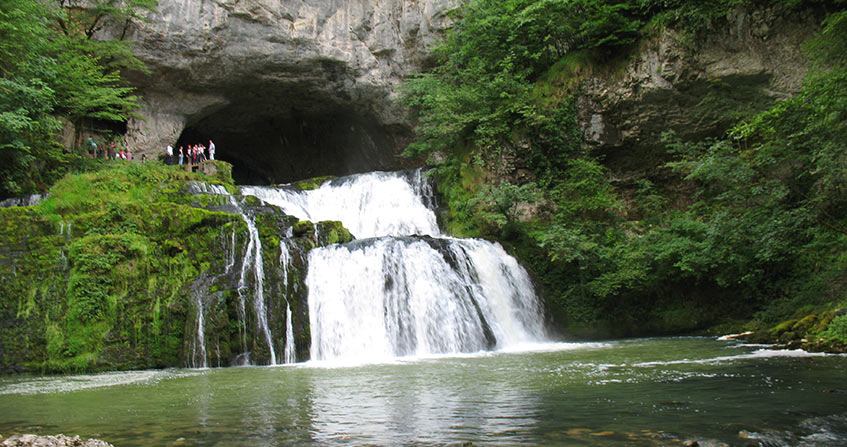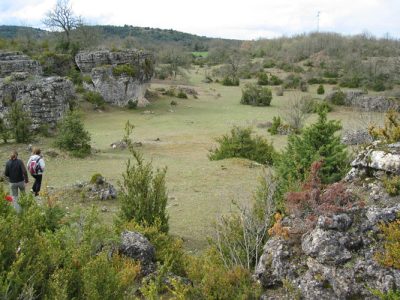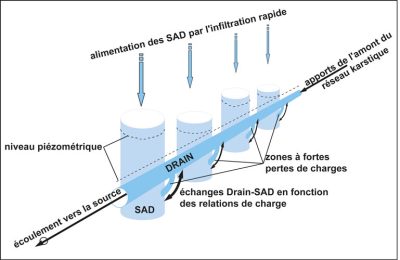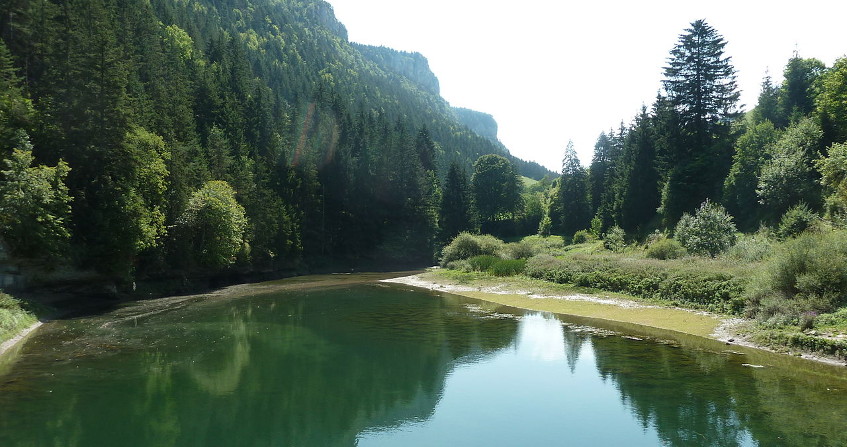喀斯特:石灰岩中的可再生水资源

19世纪斯洛文尼亚的喀斯特区域因其水文等特殊形式而进入研究者的视野,该区域被认定为世界上碳酸盐岩、石灰岩和白云石岩景观与地下潜流的典型参照。喀斯特定义为一类由碳酸盐岩、石灰岩和白云石岩构成的天然地下水文地貌,包含了大量可以容纳人类的洞穴。这些洞穴往往通向壮观的泉水,自古以来常常被用于供水。喀斯特地貌的成因与演化过程都与含水层有关,富含水资源,可供开发利用。解释这一地貌的特殊性,需要了解其水文地质特征和功能,以便合理利用其资源,避免过度开发。
1. 喀斯特:一种重要而复杂的地质介质
喀斯特作为广为人知的著名地貌,是由碳酸盐岩、石灰岩和白云岩组成的一种地质构造。它本质上属于含水层,地下水在其中积聚、循环和涌现。它作为一种特殊的地下水库,非常值得关注。

[资料来源:摘自沃坎(WOKAM)项目[世界喀斯特含水层地图-见参考文献[1]]
这些喀斯特地层覆盖了全球大陆面积的12%-15%。在法国,它们占据了国土面积的35%,是水资源的重要来源。由于碳酸盐岩还会在其它类型的地质构造下延伸,喀斯特含水层的实际面积可能更广。根据最新的估计(图1),近50%的法国领土受到了喀斯特地层的影响。喀斯特含水层中的水资源占法国饮用水总供应量(drinking water supply, DWF)的40%。据估计,喀斯特为25%的世界人口提供了生活用水[1]。
在大多数含水层中,水在由岩石变形产生的原始孔隙或裂隙中循环与积聚。喀斯特含水层与普通含水层的不同之处在于,流经这些原始孔隙的水使部分孔隙发生巨大变化,乃至形成可供人类进入的孔道和空洞。这种转变所需要的时间在地质尺度上很短——几千年到几万年。喀斯特不仅是含水层,还是一种地质系统。
喀斯特的经济效益不限于饮用水,也广泛关系到农业灌溉、工业利用。喀斯特是温泉活跃区,富含地热和矿物质资源。喀斯特也往往是石油沉积区,例如阿拉伯的油田。喀斯特还可能含有金属矿床,如铝土矿、铁矿、铅矿和锌矿。喀斯特对土建工程的影响不容忽视,在建造大坝和水库时尤需留意。
本文将对喀斯特的概念、成因、结构、功能和管理加以介绍。
2. 喀斯特地貌的特殊性

[图片来源:《喀斯特地区地下水资源的知识和管理》-巴卡洛维茨(Bakalowicz)-1999。技术指南n°3,里昂罗纳地中海科西嘉水务局]
(Terrains non karstiques:非喀斯特地形,Perte de rivière:河流损失,Doline:落水洞,Aven d’effondrement:溶井滑塌,Poljé:喀斯特盆地,Vallée sèche:干谷, Résurgence:重现,Reculée:远程,Champ de lapiaz:喀斯特沟区域,Canyon:峡谷,Rivière souterraine:地下河,Faille:故障,Grotte:洞穴,Source temporaire ou de trop plein:临时或溢流源,Source vauclusienne:洞泉,Niveau de base:基准面,Alluvions:储蓄量,Calcaires:石灰岩,Terrains imperméables:非渗透区域)
喀斯特由地表和地下两部分组成,其形成原因是土壤空气中的二氧化碳溶于水呈酸性,溶解碳酸盐岩(石灰岩、白云岩)后产生空隙,可供地下水在其中流动和储存。这一过程将石灰岩或白云岩地层转化为具有岩质、裂缝、孔穴、地下河和个性化洞泉的喀斯特地块,称为喀斯特作用或岩溶作用(阅读焦点1:喀斯特作用的机制)。
如图2和图3的照片所示,喀斯特地貌的特征是表面有几米到几公里宽的封闭洼地,能够快速吸水。较小的洼地称为落水洞(图4),有时通过与裂缝(或洞穴)相连而快速吸收雨水。最大的洼地称为喀斯特盆地,从流经不透水地区的河流中接收大量的水。落水洞将这些水吸收到石灰岩中,为泉水提供补给。落水洞下游的山谷则往往处于干燥状态,它们的底部也有封闭洼地的遗迹。

当岩石裸露时,初始裂缝会变宽而形成波纹、尖峰或廊道;或是加深而变成沟槽(喀斯特沟),沟槽中汇集了由径流、降水和风带来的土壤和沉积物。在这些沉积物的长期填充和溶蚀作用下,喀斯特沟会演变成更圆的形状。

喀斯特也是令人惊叹的泉水来源,如卢瓦尔瑞的源头或泉水城。喀斯特山体表面的干燥和山谷中水源的丰润形成鲜明的对比。喀斯特泉的集水区称为喀斯特系统,由地表径流和能够渗水的钙质岩层组成。泉眼的位置取决于系统的基准面,也就是石灰岩岩层露头的最低点。它通常在一片喀斯特区域中位于河谷的底部,有时甚至位于石灰岩的底端,直抵不透水层。
3. 喀斯特的地质与气候成因
将地表水排入水源的孔道结构一旦形成,喀斯特系统便会和其他所有水系一样,受到气候和地质条件变化的影响。区域基准线的长久变化刻画了大陆岩石圈的地质历史。这一过程可能与海平面的变化有关,例如第四纪冰河期的全球海平面比现在低120米;或者与板块的地质构造运动有关,例如沉降与过度反应致使了山脉和盆地的形成。这些变化过程通过增加或减少地下水流量改造外部环境,从而塑造地下管道网络,这一塑造能力被称为喀斯特作用势或岩溶作用势(Karstification Potential),简称KP(阅读焦点1:岩溶作用机理)。
过度反应使基准面降低,KP增加,形成新的管道网络;同时旧网络被废弃或部分废弃,转化为渗透区,形成足以容纳人类的洞穴。根据含水层几何结构的不同,将会出现以下几种情况:喀斯特系统的合并、喀斯特系统的分裂、水源的转移、溢流源的出现等。这些情况使排水过程更为复杂,系统功能因此得以发挥。
另一方面,沉降使得基准面上升,KP降低,管道网络部分阻塞或彻底堵塞,造成喀斯特系统的溢流。被淹没的管道网络(见图2)构成了数亿立方米的蓄水结构,使含水层具备很好的调蓄能力[2]。
在沿海地区,由海平面上升造成的海侵对喀斯特系统产生不同程度的影响。当海侵过程带来不透水的海洋沉积物时,沉积物将会填充盆地;如果没有海洋沉积物的话,通向大海的管道网络则能够趁机交换海水。交换情况取决于含水层淡水和外界海水之间的水力负荷(压力)关系。当水力负荷较高时,淡水可从含水层中逸出;当负荷较低时,海水将进入含水层。
事实上,淡水和海水之间的密度差异是两种液体各自运动的主因。由于淡水(1.0)和盐水(平均1.025)之间的密度差异,管道中的淡水高度必须比海平面高度高出一定差量,才能将盐水推出管道,随后淡水得以排入大海。当差量减小时(无淡水补给或涨潮时),海水随之从水下喀斯特结构进入管道,与淡水混合,形成的咸水盐度随着含水层中淡水补给的减少而增高。这一原理也适用于沿海地区的泉水,由于自然条件下海水侵入管道,使这些泉水含有一定盐分;法国鲁西隆的丰特斯特拉马尔泉就是这类情况[3]。陆地上的钻孔抽水活动很大程度上加剧了海水的自然入侵,即使这些钻孔距离海洋很远也不例外[4]。
全球的海平面变化缓慢且有限。在最近一次冰川作用中,海平面先下降,然后上升约120米。但地中海盆地发生的特殊地质事件——梅西尼亚盐分危机,其规模相当大,而且是岩溶地下水资源高度集中的根本原因(阅读焦点2:梅西尼亚盐分危机及其对岩溶的影响)。
4. 重要的定义:含水层

喀斯特不仅是一类景观,更重要的是,它是一类由含水层构成的水文系统。地下水流在地表形成了封闭的洼地和深坑,这些区域将优先吸收水流;地表的景观有时保有了以往河流组织的遗迹,如干燥的山谷和冲积单板;这种结构会逐渐瓦解,有利于地下水在不同大小的裂缝和管道中流动。
与其他含水层相比,喀斯特具有以下特点:
- 喀斯特是一个通向水源的管道网络。水流创造出孔隙并塑造其形态,这一过程是不可逆的。孔隙随之构成了排水管道网络。喀斯特是许多壮观泉水景观(Fontaine de Vaucluse、Lez源头、Loiret源头等)的水源。
- 喀斯特是一类流量变化很大的水源(见图5)。例如随着季节的变化,雷兹河源头的自然流量会从低水位时的每秒几百升变化到高水位时的每秒30立方米(译注,即每秒3万升)[5]。
- 喀斯特提供了人类可以进入的石质廊道。喀斯特内部孔洞的大小和形状会随着时间的推移而变化,直至可以部分被人类通过。洞穴(例如阿尔芒洞穴、帕迪拉克深渊、克拉穆斯洞穴、德米塞列斯洞穴、德拉科卡利埃洞穴)就是由以往的被废置的沟渠管道网络构成,洞穴整个或者部分由地下水流塑造。
- 喀斯特具有复杂的地下循环结构。喀斯特含水层有相当大的非均质性,无论是孔隙的大小(从几微米到几公里长)还是地下水流的流量(从每年几十米到每小时几公里)。
因此,无论是在渗透区还是在溢流区,喀斯特含水层均比单纯的孔隙或裂隙含水层复杂得多。
4.1. 渗透的特殊区域

[图片来源:《表层喀斯特作用》-巴卡洛维茨(Bakalowicz)-2013,地貌学专著,6,164-171.J。FShröder,Ed.San Diego,Academic Press]
(Couverture pédologique continue: 土壤覆盖的延续, Proto-doline: initiationd’un système doline-puits:原落水洞:落水洞-井系统的原型,Lapiaz:喀斯特沟,Sol restant dans les fentes du lapjaz après érosion:侵蚀后喀斯特沟缝隙中土壤的保留,Infiltration lente:缓慢渗透)
在喀斯特沟壑中孕育出一定数量的宽阔垂直管道,例如穿过渗透带的裂缝和落水洞,如此形成了“沟-井”系统(图6)。在这些轴线之间,岩石中的裂缝直接快速地将水排入溢流区,通过简单的机械松弛作用,增加了不同宽度。这一过程在山谷的斜坡上,通过树根的溶解作用得以加强。喀斯特沟的实例如图7和图8所示。

[图片来源©M.巴卡洛维茨(Bakalowicz)]
与深层岩石相比,近地表区域的渗透性更强。因此渗透水被局部保留,并在浅层区域形成饱和区,即区域内所有孔隙都被水填充,水在孔隙中流动,空气和水的混合物在其上方循环。由于这一区域是由旁侧的沟-井系统进行排水的,因此这一区域是不连续的。水也通过岩石裂缝缓慢渗透并注入地下岩层(包括洞穴中的岩层)。

[图片来源©M.巴卡洛维茨(Bakalowicz)]
这一“栖息饱和区”为植被覆盖层的蒸散提供了水分,这些植被覆盖层因此能够承受漫长的旱季。这类含水层被称为表层喀斯特[6]。小型泉水和废弃槽井的痕迹证明了人类曾经利用过这类含水层。表层喀斯特将地表群落和地下群落联系起来:一些动物,如微甲壳纲动物、甲虫和更常见的土壤动物,会在地表定居并逐渐适应地下环境[7];表层喀斯特也是地下生物寻觅大量食物的地方。植被、土壤以及生物多样性的保持也在很大程度上依赖于这些表层喀斯特含水层。表层喀斯特由“喀斯特沟-落水洞-高位含水层”系统构成。
因此,喀斯特的渗透带[5]受到以下几种流动模式的影响:
- 表层喀斯特近地表处蓄水的延迟渗透,这一过程受到土壤生物地球化学过程的影响(降水中的溶解盐通过蒸发蒸腾作用被浓缩、溶解元素在粘土-腐殖酸复合体中进行交换、CO2的产生等);
- 落水洞系统中的直接快速渗透——落水井和开放程度极高的裂缝所形成的真正的地下径流,这一过程与岩石在深处的溶解密切相关;
- 缓慢的两相渗透——空气和水的混合物穿过岩石的细裂缝和孔隙,将地表附近的碳酸盐岩溶解,这一过程将溶解态二氧化碳和气态二氧化碳输送到整个渗透区;
- 集中快速渗透——由流经非喀斯特区域的河流补给,这一区域的水流与石灰岩未接触(图2)。
这些不同的渗透方式在不同的空间和时间尺度上以不同比例为饱和区域或浸没喀斯特区提供补给。
4.2. 围绕排水和储存的浸没区域

[图片来源:根据Marsaud,B(1997),根据实验结果确定岩溶淹没区的结构和功能。巴黎南奥赛大学博士论文:BRGM文件,Orléans]
(SAD:排水辅助系统,DRAIN:排水,alimentation des SAD par I’infiltration rapide:快速渗透对SAD的补充,apports de I’amont du réseau karstique:喀斯特系统上游提供水源,zones à fortes pertes de charges:压强损失较大区域,échanges Drain-SAD en fonctiondes relations de charge:根据负载关系进行排水和SAD交换,écoulement vers la source:流向源头,Niveau piézométrique:测压水平计量线)
浸没喀斯特区渗透性的分布非常不均匀,渗透系数[8]在10-7到10-1 m/s量级之间,而且这种异质性并不是随机分布的。浸没喀斯特区由渗透性非常高的管道(见图4和图5)和轴线组织,形成一个层级网络,这一组织方式与河网非常类似。水在这些排水沟及其周边环境之间流动。水由于在周边环境中流动速度较慢而被储存起来。这些区域渗透率较低,由岩石的孔隙和裂缝组成,被称为“基质”或“基质块”。它们也是大型的喀斯特孔隙,构成基本储水层,并且彼此间相互独立。A. Mangin将这些储水层称为排水辅助系统(Drainage Ancillary Systems,DAS)[9]。

[图片来源:A. Mangin见参考文献8和2]
(Zone épikarstique:喀斯特区域,Terrains non karstiques:喀斯特区域,Perte:(水量)损失,Ruissellement souterrain:地下径流,Infiltration rapide:快速渗透,zone d’infiltration:渗透区域,Infiltration lente:缓慢渗透,Niveau piézométrique:测压水平线,Karst noyé:淹没的喀斯特,Drain:排水,Exutoire:出口,Niveau de base:基准面)
如图9所示,DSS是快速渗透管道轴线底部的淹没区中形成的一些空腔。由于管道的复杂性,或是因为只有原始裂缝才能确保水力连续性,DSS通过排水区连接到管道,排水区内部压强迅速下降。这种情况导致了DSS和基质内部的巨大压强变化幅度。溢流水位和低水位之间的跨越距离从几十米到几百米不等,在快速渗透管道中则距离很近。径流的产生与彼此间的荷载关系紧密相关,有时从管道流向DSS或栅块,有时则反向流动。因此,喀斯特环境有两种类型的孔隙,分别具有排水和蓄水两种不同的水力功能,如图10所示[9]。
5. 喀斯特地区的地下水开采
地中海地区的一些古老文明是在喀斯特泉水周边被创造和发展起来的。中东、希腊、罗马及其殖民地的巨大古城的发展都离不开喀斯特泉提供的水源,例如巴勒贝克、大马士革、提尔、雅典、罗马、迦太基或尼姆都是沿着喀斯特泉的分布兴建输水管网而向外扩张的[10]。这些沿河工程的规模受到水流量的限制,因此需要通过寻找新水源和开发新设施来满足不断增加的城市用水需求,例如罗马和里昂修建了新的集水渠和输水管道。
人们在随后的一段时间使用喀斯特水源时,没有考虑到喀斯特的特殊之处,也没有考虑任何水质问题[11]。直到19世纪末,法国和奥地利的第一批洞穴学者才揭示了泉水与万人坑洞穴之间的关系,将这些污染与某些流行病(如白喉、伤寒等)之间联系起来。法国制定了严格的法规限制喀斯特地下水资源的开发和研究,并强制规定社区必须使用其他类型的地下水和地表水资源。
在当时人们的印象中,喀斯特是一类荒凉的景观,由几个位于地下深处并直接连接落水洞和泉水的大型管道组成[12]。位于塞文内斯边缘的布拉马比奥地下河由高斯坎普里厄的幸福泉奔涌汇集而成,被当作喀斯特地区所有地下水流的模型。因此在法国,高斯泉也被认为是一类典型的喀斯特系统。但由于喀斯特导致的系列事件,在很长一段时间内,高斯泉不允许被用作水源。
5.1. 对人类活动极度敏感的环境
单薄且不连续的土壤层通常对侵蚀非常敏感。森林砍伐、放牧或火灾加剧了喀斯特沟的侵蚀和退化,而喀斯特沟的消失又阻碍了植被的重建。这些由人类活动导致的裸露而干燥的结构无法完成自然的水过滤过程。
此外,大孔隙和高流速使水快速转移,导致水源中的污染物来不及被稀释或过滤。因此,通常认为喀斯特含水层中的水不适于饮用。为喀斯特EAF集水区提供有效保护措施也相当困难。主要难点在于对如此巨大的水源盆地开展水文地质学研究,需要耗费大量的时间与金钱。在物理意义上,喀斯特的脆弱性质是由一系列不利因素共同导致的,例如流速快、缺乏过滤和自净能力、稀释或扩散效果有限等。
但另一方面,这种脆弱性赋予了喀斯特一些有趣的特征,例如:一些意外污染通常能被快速消除,这与地下水停留时间短有关;延迟效应(吸附、分散)往往可以忽略不计;在水文循环尺度下,长期或季节性的污染排放变化将导致水质迅速变化(枯水期由于水流缓慢,可保持良好或极优的水质,而洪水期则可能受到浊度、细菌或化学污染的影响)。
学界提出了一种在喀斯特区建立集水区保护边界的措施[13],运用多准则分析法描述喀斯特水资源的脆弱性。主要的参考标准是土壤和表层喀斯特、渗透模式以及排水系统的性能。这一方法对喀斯特系统进行系统性分析,将其划分为小网格,对所有标准综合考虑,加权计算后得出描述脆弱性分布的风险图。
对喀斯特EPA进行系统性水处理通常可以避免细菌污染风险。化学污染风险(如过量硝酸盐)在洪水期间会被迅速消除,这是因为在这些地区,人为影响程度较低或污染物累积量少。另一方面,水流浑浊[14]的问题反复出现,尤其是在诺曼底地区、一些石灰岩区域、或是含水层大量由河流流入补给的区域。因此沉淀和过滤系统十分有必要。在喀斯特供水异常时,可以使用临时的替代水资源或通过远离喀斯特管道的井眼取水。
5.2. 大量的饮用水供应
在地中海国家,尽管喀斯特水源有时会被污染或受到海水自然入侵,但它往往是唯一可用的含水层水源。更重要的是,喀斯特通常是这些地区河流的唯一专属水源。它在许多水系中起着至关重要的作用,因此在开发和保护水资源时必须予以重视。

[图片来源©M.巴卡洛维茨(Bakalowicz)]
随着水资源需求的增长和技术的进步,人们开始通过水泵或钻井从水源地直接抽取地下水(图11)[15]。但是含水层中孔隙的不均匀分布意味着抽水井命中孔隙的概率极低。鉴于孔隙的相对尺寸较小(通常几米,仅少数可达几十米),很难通过地球物理方法确定位于地面30或40 米以下的孔隙位置[16]。磁定位法可以探测位于地下300至400 米的孔道,前提是操作员能够携带超大功率的信号发射器进入。这也是开采蒙彼利埃的雷兹泉时,用于确定钻探位置的方法[17]。在其他案例中,这一方法被用于探查廊道旁的淹没区域,瑞士侏罗[18]中的情况就是如此。
鉴于喀斯特含水层的巨大尺度及其结构和功能的复杂多样性,需要采用多学科交叉的方法对其进行详细研究。水文地质学家通过专业的工具来描述喀斯特的功能,确定其最具生产力的区域,并正确评估其资源储量[19]。
在枯水期,含水层水资源的开采量可以高于自然流量;这些水资源的储量将在雨季得到补充。与地表水库储水相比,开采喀斯特地下水的优势在于地下水不受蒸发影响,更重要的水质不易受到污染。与人工水库的共通之处在于,喀斯特地下水的供应(补充)和排空(排出)条件同样需要研究和评估。为此,J. V. Avias团队通过全局模型,探寻到了蒙彼利埃雷兹泉的源头[5] [18]。一系列研究表明,对喀斯特含水层进行精细化研究和网格化监测,有利于实施可持续的水资源严控措施,而且可以有效控制下游的洪水风险。此外,人工补充喀斯特水资源的方法也具有可行性,这也是对喀斯特含水层进行主动管理的措施之一 [20] [21]。
6. 水资源管理的前景
喀斯特系统可以提供大量的地下水资源,且易于通过泉水或钻井的方式开采。由于缺少自然过滤保护,分散效应较弱,其含水层对污染非常敏感。然而,由于水流湍急,平均停留时间通常不到一年,其水资源的更新速度远快于孔隙和裂隙含水层中。先前水文循环中发生的诸如干旱、临时的过度开发、意外或季节性的污染等事件,对喀斯特含水层的影响微乎其微。其水资源还可通过河水内流得到人工补充。
水文地质学家和水资源管理者现在已建立了一套有效的方法来表征、模拟和管理喀斯特地质环境。在水资源管理政策中,喀斯特的地位举足轻重,常常能在大型水利工程缺位的情况下提供饮用水资源储备和旱涝调蓄能力。
参考资料及说明
封面图片:来源于Lison (Doubs)[图片来源©M.巴卡洛维茨(Bakalowicz)]
[1] Chen, Z., Auler, A. S., A. S., Bakalowicz, M., Drew, D., et al. (2017). The World Karst Aquifer Mapping project: concept, mapping procedure and map of Europe. Hydrogeology J. , 25, 771-785.
[2] El Hakim, M., Bakalowicz, M. (2007). Significance and origin of very large regulating power of some karst aquifers in the Middle East. Involvement on karst aquifer classification. J. Hydrology, 333, 329-339.
[3] Fleury, P. (2005). Mediterranean underwater springs and coastal aquifers. Operation and characterization. PhD thesis, Earth Sciences, University of Paris-6.
[4] El-Hajj, A. (2008). The karst carbonate aquifer of Chekka (Lebanon) and its underwater outlets. Hydrogeological characteristics, operation and modelling. PhD thesis, HydroSciences Montpellier and CREEN-ESIB Beirut. University of Montpellier 2. Encyclopédie de l’environnement13/14Généré le 04/09/2021
[5] Marshal, J. C., Vestier, A., Jourde, H., Dörfliger, N. (2013). The Lez hydrosystem: active management for a challenging karst. Karstologia, 62, 1-6.
[6] According to Bakalowicz, M. (2013). Epikarst Processes. Treatise on Geomorphology, 6, 164-171. J. F. Shröder, Ed. San Diego, Academic Press.
[7] Rouch, R., Danielopol, D.L. (1987). The origin of underground aquatic fauna, between the refuge paradigm and the model of active colonization. Stygologia, 3, (4), 345-372.
[8] According to Darcy’s law, the water flow rate D flowing through a permeable layer of thickness L and cross-section A is proportional to the pressure difference DP, expressed as water height DH, and inversely proportional to L, D = KA DH/L. K is the permeability coefficient, also called hydraulic conductivity.
[9] Mangin, A. (1975). Contribution to the hydrodynamic study of karst aquifers. Part 1. General information on karst and the flow laws used. Ann. Caving, 29, (3), 283-332. Part 2. Methodological concepts adopted. Karstic systems studied. Ann. Caving, 29, (4), 495-601. Part 3. Constitution and functioning of karst aquifers. Ann. Caving, 30, (1), 21-124.
[10] Bakalowicz, M., Fleyfel, M., Hachachach, A. (2002). An ancient history: the catchment of the Ras el Aïn spring and the water supply to the city of Tyre (Lebanon). La Houille Blanche, 2002, (4/5), 157-160.
[11] Bakalowicz, M. (2012). Fountains of Montpellier, France. From private and unsafe to public and safe water supply. In: Water fountains in the worldscape, 72-78. H. A. J., P. S. Juuti and T. S. Katko, Ed., International Water History Association.
[12] Martel, E. A. (1925). Geological contamination of groundwater. Ann. Public, industrial and social hygiene, 1, 1-48.
[13] Vier, E., Silent, P. (2006). Assessment and analysis of the implementation of perimeters for the protection of AEP catchments in karst environments. Rhône Méditerranée and Corsica Water Agency, Lyon.
[14] Masséi, N. (2001). Transport of suspended particles in the karst chalk aquifer and at the chalk/alluvial interface. PhD thesis. Continental and coastal morphodynamics. University of Rouen, Rouen.
[15] Bakalowicz, M. (2005). Karst groundwater: a challenge for new resources. Hydrogeology J. , 13, (1), 148-160.
[16] Al-Fares, W., Bakalowicz, M., Guérin, R., Durkhan, M. (2002). Analysis of the karst aquifer structure of the Lamalou area (Herault, France) with ground penetrating radar. J. Applied Geophysics, 51, (2-4), 97-106.
[17] Avias, J. V. (1995). Active management of the karst exurgence from the source of the Lez (Hérault, France) 1957-1994. Hydrogeology, 1995, (1), 113-127.
[18] Tripet, J. P. (1972). Hydrogeological study of the Areuse spring basin (Neuchâtel Jura). Thesis Doctor of Science. Neuchâtel Encyclopédie de l’environnement14/14Généré le 04/09/2021 Hydrogeology Centre, University of Neuchâtel, Switzerland.
[19] Dörfliger, N., Crochet, P., Guérin, R., et al. (2010). Methodological guide. Tools of karst hydrogeology. BRGM RP-58237-EN, BRGM & ONEMA, Orléans.
[20] Bakalowicz, M. (2011). Management of karst groundwater resources. In: Karst management, 263-282. P. E. van Beynen Ed., Springer.
[21] Daher, W., Pistre, S., Kneppers, A., Bakalowicz, M., Najem, W. (2011). Karst and artificial recharge: Theoretical and practical problems. A preliminary approach to artificial recharge assessment. J. Hydrology, 408, 189-202.
环境百科全书由环境和能源百科全书协会出版 (www.a3e.fr),该协会与格勒诺布尔阿尔卑斯大学和格勒诺布尔INP有合同关系,并由法国科学院赞助。
引用这篇文章: BAKALOWICZ Michel (2024年3月9日), 喀斯特:石灰岩中的可再生水资源, 环境百科全书,咨询于 2025年3月30日 [在线ISSN 2555-0950]网址: https://www.encyclopedie-environnement.org/zh/eau-zh/karst-renewable-water-resource-in-limestone-rocks/.
环境百科全书中的文章是根据知识共享BY-NC-SA许可条款提供的,该许可授权复制的条件是:引用来源,不作商业使用,共享相同的初始条件,并且在每次重复使用或分发时复制知识共享BY-NC-SA许可声明。








